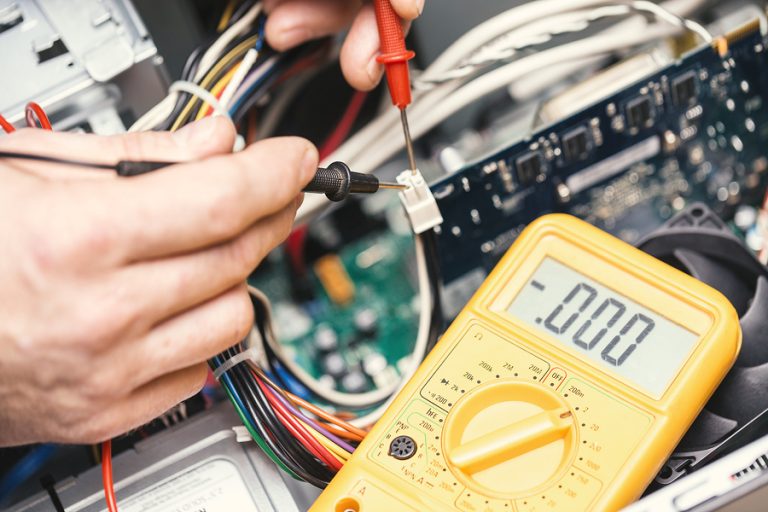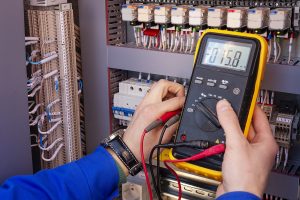The voltmeter is a device used to measure the voltage of electricity that is present in outlets and other electrical devices and access points. Voltmeters are quite common and can be found in most retail stores that carry electrical wiring and products.
However, most meters available today are called multimeters because they measure voltage, ohms, and amperage. They can be found using either digital or analog displays which show you how much electricity is present. Today, more voltmeters are made with digital displays, but the old analog ones work just as well.
Technically, a voltmeter registers the difference between the electricity present in two nodes of the circuit. And while that may sound complicated, all you really need to know is how to read it and what it means in terms of the electricity that is present.
Set the Meter
Since multimeters have different settings, the first thing you will have to learn is where to set the meter to get the reading that you want. This is usually found on a large dial in the center of the voltmeter that can be switched to different settings depending on where it is turned.
- V~: AC
- V-: DC
AC stands for alternating current. This is the current used in the household and is normally accessed through the outlets DC stands for direct current and is used in batteries and portable electronic devices. The reason why there is a difference is that DC is simpler and easier to use for small devices, but it cannot travel very far. AC is a little more complicated but has considerable range which is why it is used for the transmission of power over long distances.
Once you have chosen the AC or DC setting depending on what you are trying to read, you now need to set the range of the voltmeter to just above what you expect to find. Some multimeters have no range setting which means they will detect automatically the voltage that is present. Otherwise, you will need to set the meter to the voltage just above what you expect to find.
For example, if you are checking a 120V outlet, set the meter to 200 V~. If you are checking power tools, they should have their voltage marked on the device. Household batteries tend to be at 9 volts while a car battery is usually around 12.6 volts. If you are not sure, just set the device to the maximum setting.
Test Leads
You will see one red and one black wire with a probe on one end and a jack on the other. Put the jacks according to their color into their respective slots on the voltmeter. You will put the blackjack into the port which is labeled “COM” or common. The red jack will be put into the hole marked with a V. If you do not have such a hole on the device, place it in the one marked with the lowest number or go with mA.
Now you are ready to check the voltage. Keep in mind that the test leads are protected, but do not touch the metal on the probes when inserting them into an outlet or other electrical device. Do not allow the probes to touch each other as well.
Insert Probes
The probes or leads are what you will use to measure the voltage that is present.
Outlet
If you are using the voltmeter to check to see if electricity is present in an outlet, you set the meter to the appropriate voltage. Then, insert the black or negative probe into the larger slot on the outlet which is usually the one on the left or upper left if there is a ground. Because most black test leads have a bump on them, you can insert it into the outlet and let it go. The lead will stay in place.
Now, take the red lead and insert it into the smaller vertical slot. If you look at the display on your device, you should be getting a 120V reading. However, if you are getting an “OL”, you are overloading the voltmeter and it will need to be removed quickly before it becomes damaged. Raise the range on the voltmeter if you get an OL reading and reinsert the red lead.
Batteries
This is simpler compared to an outlet because the positive and negative poles on the batteries are marked. Set the multimeter to read for DC or V- and place the black lead on the negative terminal and the red lead on the positive one. You may have a DC+ or DC- position on the voltmeter. If so, change it to the other setting if you get no reading. If that does not work, exchange the positions of the red and black leads.
If that does not work, drop the setting on the voltmeter and go through the process again. You may have to check it with a source that you know is good first to ensure that the meter is working properly.
Additional Information
Care must be taken when you use a voltmeter. So, be sure that it turns on and is in working order before using it to test outlets, batteries, and other devices. Keep the instructional manual handy because on multimeters you can use them to measure more than just the voltage. There may be times when you need to know the amperage or ohms of an electrical circuit, battery, or device.
It pays to have a good battery around to know whether the meter is working properly. You can always use your car battery as a test. Assuming it has not been drained of electricity. This will let you know that at least the device is working, so you can focus on the battery or circuit.
Multimeters are solid-state and can be stored in a cool, dry place. There are many multimeters that are still being used decades after they were sold, so unless it gets overloaded it should last for a long time.
Founder of HandymanGuides.com and self-proclaimed “Mr. Fix-It”, Mike has countless years of experience building and tinkering with everything under the sun. He works as a local repair guy near Santa Monica, CA and when he’s not spackling drywall, he enjoys spending time with his wife and 2 daughters.








